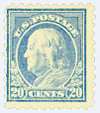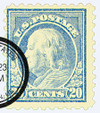
1916-17 20c Franklin, ultramarine, perf 10
# 476 - 1916-17 20c Franklin, ultramarine, perf 10
$26.00 - $495.00
U.S. #476
Series of 1916-17 20¢ Franklin
Series of 1916-17 20¢ Franklin
Issue Date: December 5, 1916
Printed by: Bureau of Engraving and Printing
Printing Method: Flat plate
Watermark: None
Perforation: 10
Color: Ultramarine
Printed by: Bureau of Engraving and Printing
Printing Method: Flat plate
Watermark: None
Perforation: 10
Color: Ultramarine
Parcel Post began in the U.S. on January 1, 1913, and enabled the mailing of packages through the U.S. postal system. It stimulated the economy and gave farmers and merchants far more opportunities to market their goods, as well as greatly increasing the U.S. Post Office’s revenue.
Special Parcel Post stamps were originally issued to meet the need, but in 1916, the system was revamped and production of Parcel Post stamps was discontinued. Regular U.S. stamps were used to ship parcels. The Series of 1916-17 20¢ Franklin stamps became popular as a means to pay the higher fees.
First Unwatermarked U.S. Stamps
In 1916, the Bureau of Engraving and Printing began producing stamps on unwatermarked paper. With the United States already close to a wartime economy as World War I raged in Europe, the lower cost of single mark paper added up to big savings for the Bureau. However, single watermarks on previous stamps were often quite hard to identify, and collectors were slow to recognize that a new type of paper was being used.
Adding to the confusion was the continued use of 10 gauge perfs. A year earlier, 11 gauge perforations had been introduced, and the collecting community expected to see new stamps with that gauge. But in another cost-cutting move, the BEP continued to use the 10 gauge perforating rollers until they wore out completely.
Mail During World War I
During the first part of World War I, soldiers didn’t have to use stamps to send letters within the U.S. Instead, the letters could be marked as “solder’s mail” with an officer’s signature added. The letter would then be delivered with the appropriate postal fee collected from the mail recipient. These rules didn’t apply to registered and Special Delivery mail. When the fighting began in 1917, the requirement for an officer’s signature was dropped, and from then on, all military mail carried the postmark of the U.S. Postal Service.
As U.S. troops began arriving in France, it became apparent that a postal system needed to be organized. Arrangements were quickly made with the French government for soldiers to use the French postal service. It was decided that mail to the troops would be marked “par B.C.M.” (Bureau Controle Militaire), while mail from military personnel would be marked “F.M.” (Franchise Militaire) as well as “soldier’s mail.” Letters bearing these marks would not be charged postage.
However, many soldiers were not made aware of these privileges and sent their mail through the U.S. Army Post Office’s (APO) setup in France. These early letters carried stamps or postage dues. Finally, in October of 1917, an act provided that “soldiers, sailors, and marines assigned to duty in a foreign country could mail letters for free.” The upper-left corner had to carry the sender’s name and the unit in which he was serving. In addition, the letter had to be marked “On Active Service” (OAS) and “soldier’s (sailor’s, marine’s, etc.) mail.”
U.S. #476
Series of 1916-17 20¢ Franklin
Series of 1916-17 20¢ Franklin
Issue Date: December 5, 1916
Printed by: Bureau of Engraving and Printing
Printing Method: Flat plate
Watermark: None
Perforation: 10
Color: Ultramarine
Printed by: Bureau of Engraving and Printing
Printing Method: Flat plate
Watermark: None
Perforation: 10
Color: Ultramarine
Parcel Post began in the U.S. on January 1, 1913, and enabled the mailing of packages through the U.S. postal system. It stimulated the economy and gave farmers and merchants far more opportunities to market their goods, as well as greatly increasing the U.S. Post Office’s revenue.
Special Parcel Post stamps were originally issued to meet the need, but in 1916, the system was revamped and production of Parcel Post stamps was discontinued. Regular U.S. stamps were used to ship parcels. The Series of 1916-17 20¢ Franklin stamps became popular as a means to pay the higher fees.
First Unwatermarked U.S. Stamps
In 1916, the Bureau of Engraving and Printing began producing stamps on unwatermarked paper. With the United States already close to a wartime economy as World War I raged in Europe, the lower cost of single mark paper added up to big savings for the Bureau. However, single watermarks on previous stamps were often quite hard to identify, and collectors were slow to recognize that a new type of paper was being used.
Adding to the confusion was the continued use of 10 gauge perfs. A year earlier, 11 gauge perforations had been introduced, and the collecting community expected to see new stamps with that gauge. But in another cost-cutting move, the BEP continued to use the 10 gauge perforating rollers until they wore out completely.
Mail During World War I
During the first part of World War I, soldiers didn’t have to use stamps to send letters within the U.S. Instead, the letters could be marked as “solder’s mail” with an officer’s signature added. The letter would then be delivered with the appropriate postal fee collected from the mail recipient. These rules didn’t apply to registered and Special Delivery mail. When the fighting began in 1917, the requirement for an officer’s signature was dropped, and from then on, all military mail carried the postmark of the U.S. Postal Service.
As U.S. troops began arriving in France, it became apparent that a postal system needed to be organized. Arrangements were quickly made with the French government for soldiers to use the French postal service. It was decided that mail to the troops would be marked “par B.C.M.” (Bureau Controle Militaire), while mail from military personnel would be marked “F.M.” (Franchise Militaire) as well as “soldier’s mail.” Letters bearing these marks would not be charged postage.
However, many soldiers were not made aware of these privileges and sent their mail through the U.S. Army Post Office’s (APO) setup in France. These early letters carried stamps or postage dues. Finally, in October of 1917, an act provided that “soldiers, sailors, and marines assigned to duty in a foreign country could mail letters for free.” The upper-left corner had to carry the sender’s name and the unit in which he was serving. In addition, the letter had to be marked “On Active Service” (OAS) and “soldier’s (sailor’s, marine’s, etc.) mail.”
















